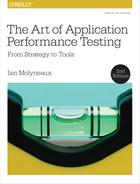Appendix A. Use-Case Definition Example
This appendix contains an example use-case definition taken from a real performance testing project. Figure A-1 demonstrates the sort of detail you should provide for each use case to be included in your performance test. The example is based on a spreadsheet template that I have developed to capture use case information.
Ideally, you should create a similar template entry for each use case that will be part of your performance testing engagement.

Figure A-1. Sample use-case definition
Please see the following for an explanation of the template contents:
- Use Case 1
-
Each use case should have a meaningful name such as “Bill Payment” in the example.
- PageViews
-
This is a calculated value based on the number of web page view per use case step where this is relevant.
- Step
-
The order that this step occurs in the use case.
- Section
-
There are three options available:
- Init
-
Whether this use case step is to occur only once at the start of a performance test.
- Body
-
Whether this use case step is to be iterated during performance test execution.
- End
-
Whether this use case step is to be executed only once at the end of a performance test.
- Action
-
A description of the user action required for this use case step (e.g., step 1 requires the user to “Enter online banking number, an Internet password, and then click Continue”).
- Timing name
-
A label to identify the use case step during performance test execution and analysis (e.g., the timing name for step 1 is “Login Step 1”).
- Step test data (as appropriate)
-
It is a common for use case steps to require data entry. This section of the template attempts to capture information about any test data that may be required.
- Source
-
The origin of the test data. This could be an external data file as indicated against step 1. Alternatively, it could simply be a hardcoded value or provided by the Client UI as indicated for the other use case steps.
- Filename
-
The name of an external data file if this contains the test data required.
- Range
-
Any limits on the upper or lower value of the test data required (e.g., the requirement may be for a range of values between 1 and 100).
- Volume required
-
The number of unique test data items required (e.g., step 1 requires 2,500 unique sets of login credentials).
- Step SLA
-
Whether there is a service level associated with this use case step. Typically a maximum response time.
- Post-step think time
-
If any delay or pause should occur before execution of the next use case step.
- Page view
-
Whether this use case step results in one or more web page views. A useful thing to know when creating a load model if one of your performance targets is based on a certain number of page views per second.
